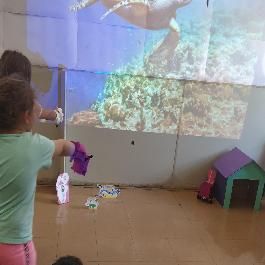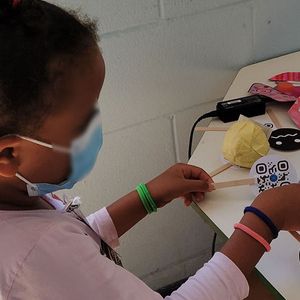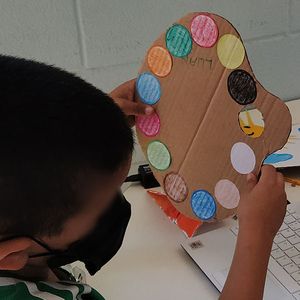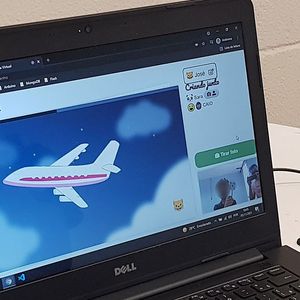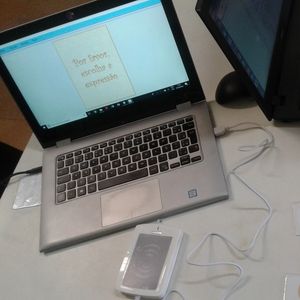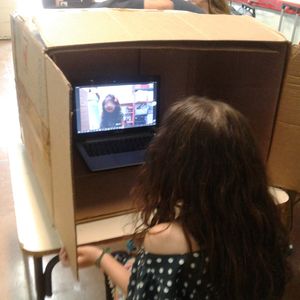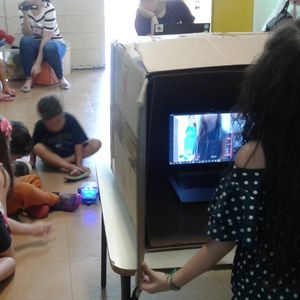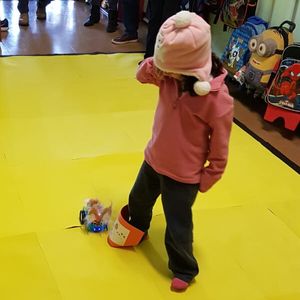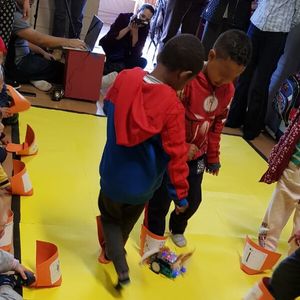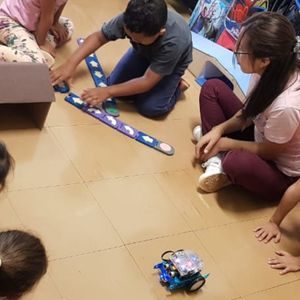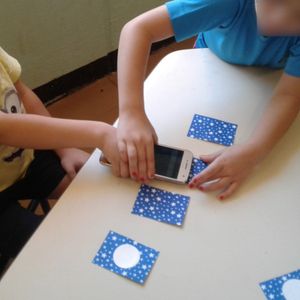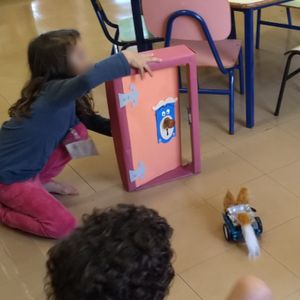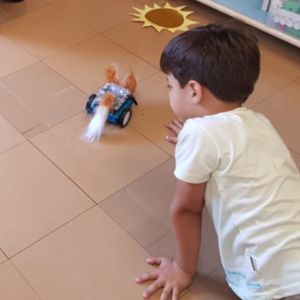Wearable Interfaces, Robotics and Creative Learning
During the second semester of 2022, we held a workshop to explore creative learning with kindergarten children using the GloveBot artifact that consists of four gloves and a robot car that have embedded Arduino technology.
With the participation of the teachers, we planned an activity to show the artifact to the children. As an initial activity, each child chose a glove and experimented with the GloveBot artifact. Then the group of children was organized to work in teams of four; and each member of the team used a glove. Each team had to move the robot car towards a toy garage using hand gestures through their gloves. For the second workshop, the children were also organized into teams of four. Each group created a story and drew characters from the story. The robot car was decorated with the children's drawings to represent different characters. The teams moved the robot car using the gloves of the GloveBot artifact as their stories developed in a scenario that had objects and projector that showed different scenes related to the story.
The GloveBot provided the involvement of each child (attention, body and action) as well as the identification of other people's actions. In addition, our artifact allowed the children to interact together in a coordinated way and reflect on the result of their actions. Regarding creativity, our artifact allowed the active involvement of children during the telling of their own stories and the practice of skills such as collaboration and spatial perception.
The Wearable Interfaces, Robotics and Creative Learning workshops were proposed and conducted by researcher Marleny Luque Carbajal as part of her doctorate, in the context of the Socioenactive Systems project.
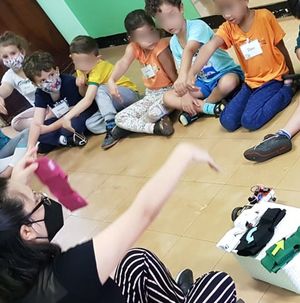
Researcher presenting the artifact "GloveBot"
The researcher is teaching children how to use the "GloveBot" artifact.
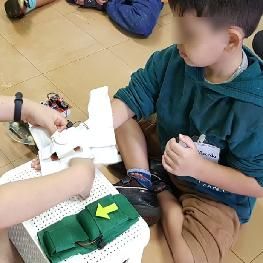
Child with white glove on the right hand
The researcher is putting the white glove on a boy's right hand. Note: The white glove represents the "Turn right" movement.
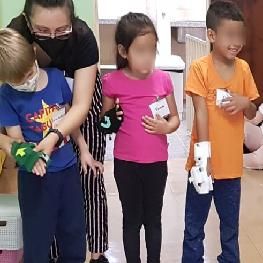
Team of children testing the "GloveBot" artifact
A group of children (three boys and one girl) are using the gloves to move the robot car. The researcher is helping a boy.
Aquarela Virtual at School
The Aquarela Virtual system was used in parallel with a video conferencing tool in which children were able to talk to each other and to the researchers remotely supporting the experiment, while two researchers were present on site.
In the system, children use homemade toys, enriched with QR codes to interact with each other in animated scenarios based on images from the song Aquarela (Vinícius de Moraes, Toquinho, Guido Morra and Maurizio Fabrizio, 1983). Participants choose avatars to represent them in the scenarios, being able to report their emotions to friends and the system with the help of emoticons. The animation sequence of the digital music scene is chosen among all the children who select a toy connected to each part of the music, a bird, a boat, a castle, a sun or an airplane, among others, and present it to the computer camera. . At the end of the activity, the system displays the “grand finale”, a compilation of photos taken by the participants during the session, to the sound of the theme music and animation elements.
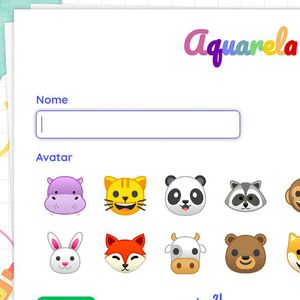
Aquarela Virtual system's initial screen
Home screen of the Aquarela Virtual system, where it is possible to choose an avatar and name to interact with colleagues.
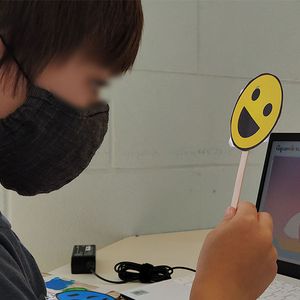
Child interacting with happy emoji (yellow) with QR code
Child interacting with happy emoji (yellow) with QR code and looking at feedback from Virtual Watercolor system on computer screen.
Lobo Robô and the Caixa Telepática
With the collaboration of teachers in previous activities, an adaptation of the Little Red Riding Hood story was carried out associating excerpts of the story with emojis compatible with the feeling reported in that excerpt. For example, the phrase “Little Riding Hood was happy to see that she had arrived at grandma’s house” was associated with the “Joy” emoji.
The workshop followed the following dynamics: inside a cardboard box, called “Caixa Telepática” (Telepathic Box), a child chooses a secret affective expression (emoji), which will be the input for a behavioral algorithm of the mBot robot, dressed as a Big Bad Wolf. After observing the robot's behavior, the other children vote with RFID cards on which secret expression they think was chosen and represented by the robot. The voting, in turn, feeds the behavioral algorithm associated with the robot, in a continuous adjustment with each new round.
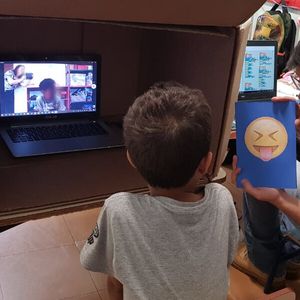
Child looking at the emotional expression he should imitate in the "telepathic box"
Child looking at the emotional expression (emoji) that he should imitate in front of the computer.

Child choosing an emoji expression
Child choosing an emoji expression from a pool with the 6 available expressions that he thinks was chosen in the "telepathic box".
Lobo Robô
The objective of the workshop was to allow the children to organize themselves to fulfill the task of guiding the mBot robot, dressed as a wolf, to a specific point in the physical scenario, in the context of a narrative created by them for the story of Little Red Riding Hood. Red. For this, an environment was created in which the process of interaction between the actors interferes in the way of acting (and reacting) of each actor, that is, the system constantly feeds back, adopting a non-deterministic behavior.
With this workshop, it was possible to create and evaluate a first version of the Socioenactive System within the educational environment, based on the analysis and recognition of patterns in the process of children's interaction with technology and with each other. Among the observed behaviors, collaboration and coordination of actions to achieve a common objective can be highlighted.
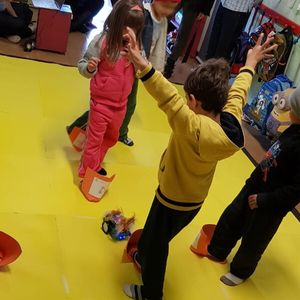
Children blocking the Robot Wolf's path with their boots
Kids blocking the way of Lobo Robo, an mBot robot dressed as a big bad wolf, front and back with his boots to help him achieve his goal.
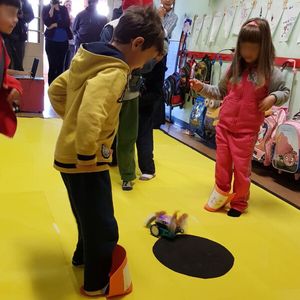
Children helping Robot Wolf to reach his goal
Kids interacting with Lobo Bot, an mBot robot dressed up as a big bad wolf, putting his boots in front of him to help him achieve his goal.
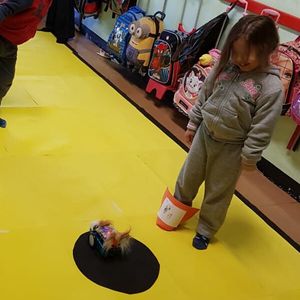
Kids looking at Robot Wolf as he reaches his goal
Kids looking at Lobo Robo, an mBot robot dressed up as a big bad wolf, as he reaches his goal.
Tangible Programming
We conducted pilot workshops with preschool teachers so that they could have their own experience with the 'TaPrEC+mBot'. In this way, the teachers collaborated in the planning of the activities that were developed in the workshops with the children. The teachers suggested using only the following programming blocks: FORWARD, BACKWARD, TURN LEFT, TURN RIGHT.
We started the workshop with the children, introducing them to the 'TaPrEC+mBot' environment and explaining how to create a tangible program. After a brief demonstration of how each block of programming works, we explained the task they had to complete, and then the children began to create tangible programs. The tasks were different for each workshop: in the first workshop, the children had to program the robot to enter a garage (a little house built of cardboard); in the second workshop, the children had to program the robot to cross a (cardboard) bridge; and in the third workshop, the children had to create their own programming scenario.
The tangible programming workshops were proposed and conducted by researcher Marleny Luque Carbajal as part of her doctorate, in the context of the Socioenactive Systems project.
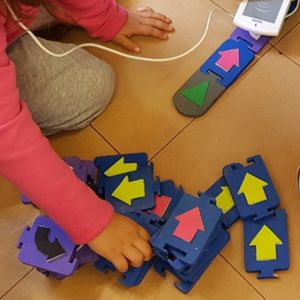
Four children creating a tangible computer program.
A girl is selecting the programming blocks, a boy is entering the program into 'TaPrEC+mBot' environment through the RFID reader. The other children are observing their classmates.
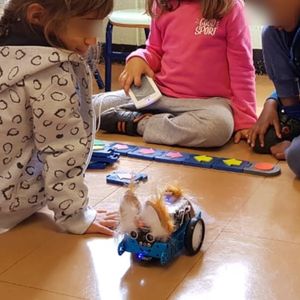
Children observing the mBot robot
Four children are observing the mBot robot in motion. mBot is running the tangible program that the children created.
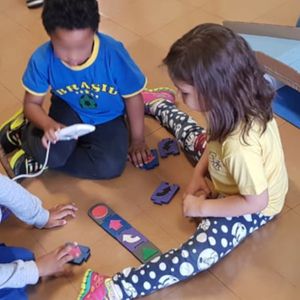
Children creating a tangible program
Three children are around the tangible program. A boy is holding the RFID reader and the other children are observing the tangible program.
Storytelling
Throughout the second half of 2018, we held storytelling workshops exploring Near Field Communication (NFC) technology. NFC is a wireless technology for exchanging data over short distances and aimed at mobile devices.
For the first workshop, with the collaboration of children and teachers, we created the Livro Mágico, a storytelling kit that supports the creation of meaningful stories. The class created a story, then the fragments of the story were narrated by the children and recorded in mp4 format. Each voice record was associated with an NFC tag. In the second workshop we carried out the TechMemory Game, a playful game with 12 cards equipped with NFC tags. Each NFC tag was engraved with a keyword from the “Little Red Riding Hood”-inspired story the kids created. In the third workshop, we created a programming scenario with objects with NFC tags. The NFC tags had recordings of fragments of a story created by the gang where the Robot Wolf (mBot) was the protagonist. The children had to program the Robot Wolf using the TaPrEC+mBot to get to the objects and discover the fragments of the story.
The Storytelling workshops were proposed and conducted by researcher Marleny Luque Carbajal as part of her doctorate, in the context of the Socioenactive Systems project.
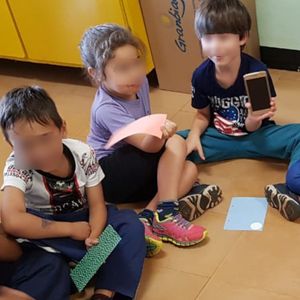
Whole class testing the "Livro Mágico" artifact.
The children are sitting on the floor in a circle. Each child has a page of the "Livro Mágico". A boy has the smartphone in his hand and he is ready to read the NFC tag.
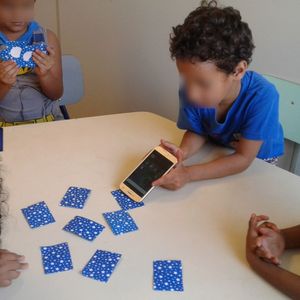
Four children playing the "TechMemory Game"
A boy is reading the NFC tag using the smartphone, another boy is counting the cards he has won, and the girls are waiting their turn to play.

